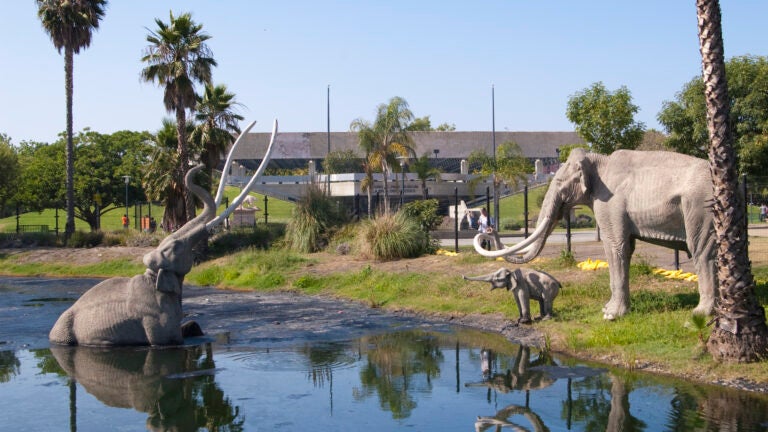
Reconstruction of a mammoth stuck in a tar pit at the La Brea Tar Pits museum in Los Angeles (Y-Z/freeimageslive.co.uk)
Oil, Mammoths, and Museums: Cross-Cultural Insights into Petroleum’s Legacy
When I first visited La Brea Tar Pits, I was immediately struck by the smell of gasoline, a scent that vividly reminded me of my hometown, an oil city in Northeast China. There, a particular bend in the road would suddenly fill with the smell of gasoline, clearly marking the transition from industrial areas to residential zones. Unlike my hometown, La Brea Tar Pits is located at the bustling heart of Los Angeles, surrounded by lively residential and commercial districts. Yet, despite the contrast in their settings, the smell of petroleum links these places. The globalization of the oil and automotive industries has made this smell familiar worldwide, across cultures and possibly even to non-human beings.
As an anthropologist from an oil city, I focus on how oil-dependent cities are navigating the climate crisis and transitioning to new energy sources, and how these shifts impact local lives. Los Angeles serves as a prime example of a successful transition from an oil-based economy, a model for other regions reliant on energy industries. This sparks my interest in how local residents view energy and environmental issues.
The La Brea Tar Pits Museum serves as a key site for my research, standing at the crossroads of Los Angeles’ environmental and industrial histories. Some 40,000 years ago, a large number of Pleistocene animals fell victim to the tar that naturally seeped from the ground here, beginning a fossilization process that has left millions of fossils buried beneath this site, creating a unique historical archive. Today, fossils of mammoths, saber-toothed tigers, birds, and plants are continuously unearthed and displayed to the public, telling a story of oil and extinction.
Supported by the Wrigley Institute, I have been able to engage more deeply with the staff at the La Brea Tar Pits and learn how researchers use these fossils to map the climatic history of the region and to understand the patterns of wildlife extinction and development in California over millennia. I also participate in every workshop organized by the museum to gain a better understanding of how this scientific institution communicates research findings through exhibitions and interactive activities.
Another reason the La Brea Tar Pits fascinated me is their connection to my hometown, Daqing, which is China’s largest oil-producing city. Daqing has long used the oil industry as a city symbol, but in the past decade, it has started to showcase Pleistocene animals like mammoths and woolly rhinoceroses in its museums, promoting the mammoth as a new city symbol alongside oil.
However, unlike in Los Angeles, where the narrative around mammoths in museums is tied to stories of extinction and environmental disasters, in Daqing, mammoths and oil are presented as having a harmonious coexistence. This reflects a broader narrative of transformation in energy cities, showing that cities with similar environmental and industrial histories can interpret and shape their pasts differently depending on their stages in the energy transition.
Yao is a visual anthropologist who uses filmmaking to help communicate research findings. This clip is from a current film-in-progress, which explores how oil and the oil industry have affected human and animal species in Los Angeles.
My interactions at the Wrigley Institute have allowed me to discuss these themes with researchers from various disciplines, broadening and deepening my understanding of cutting-edge environmental and climate issues, and enhancing my ability to conduct comparative research across disciplines and regions.
Additionally, the faculty at the Wrigley Institute have been extremely supportive of my unique approach to visual anthropology. My filmmaking has expanded my perspectives, extending my fieldwork from the La Brea Tar Pits Museum northward to the Carpinteria Tar Pits and southward to oil refining sites along the Los Angeles River. Through my lens, these varied landscapes gradually outline a clearer picture of the environmental and industrial history of Southern California. My current film project continues to evolve, and I look forward to more opportunities to blend artistic practice with cultural research, making the insights from climate and environmental studies more visually engaging and accessible to the public.
This integration of visual storytelling with academic research offers a dynamic way to communicate complex environmental themes to a broader audience, bridging the gap between scientific data and public understanding. By documenting these transitions through film, I aim to highlight the interconnectedness of human and natural histories, emphasizing the urgent need for sustainable practices in contemporary urban settings. The ongoing support from academic institutions like the Wrigley Institute is crucial for this kind of interdisciplinary research, which combines elements of anthropology, environmental science, and visual arts to explore and address pressing global challenges.
Guanyizhuo Yao is supported by the USC Dornsife Wrigley Institute Graduate Fellowship.